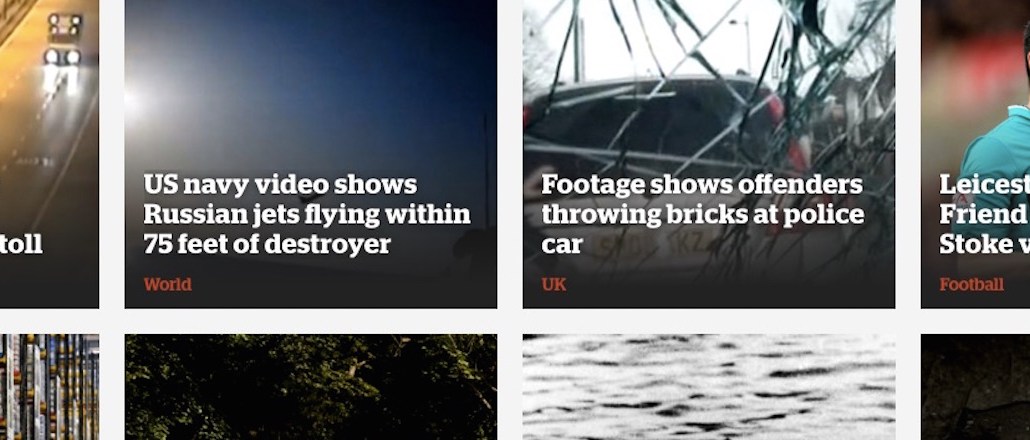How Johnston Press built its i newspaper site from scratch with an eye toward native

Johnston Press may have launched the online destination for its newly acquired i newspaper only yesterday, but the designing of it began well before the £24 million ($34 million) deal was even signed in February.
The London-based regional publisher group bought the national i print newspaper and its associated digital assets (Facebook and Twitter accounts) but no website. The i had no standalone site of its own, rather it piggybacked off former owner The Independent’s website under a “i100” subsection. So it was a gamble for Johnston to start building the new i site before it even officially owned the paper.
“We had to take a punt that we would do the deal and to start a project to build a website, which we couldn’t tell anyone about,” said Ashley Highfield, CEO of Johnston Press. “We couldn’t even tell our coders.
Building a website from scratch, with no SEO history, in today’s noisy news landscape was a challenge. But Highfield said he preferred it to having had to shell out potentially “many millions” more to buy a successful website. The site has been designed to look and feel like the print paper. “This isn’t going to be a site for cats on skateboards or pictures of Kim Kardashian’s arse. We want to focus on content that is quality, crisp and concise,” added Highfield.

Content has been divided into four verticals: Essentials; Distractions; Opinions, and Explainers, each organized in a grid.

The verticals struck David Carr, head of strategy at DigitasLbi, as a somewhat retro move, albeit one that could prove useful to advertisers. “That could be interesting for media buyers, as opposed to the usual cross-media packages, because you could be more targeted using those verticals since they represent more psychological states rather than the traditional lifestyle or sports verticals, for example.”
The drive to differentiate from “meat and two veg” inventory
Johnston Press already does a fair amount of native ad partnerships for its regional titles, which include flagship papers The Scotsman and The Yorkshire Post. It has a smallish team of eight permanent designers and product creators, and a network of 30 freelance journalists who create the content for the 300 campaigns it has run to date, all sold to advertisers as part of its WeCreate creative solutions.
It has run larger scale native ad projects for Tesco, East Coast train, Virgin, RBS, and another with a “high-end retailer” on the verge of being signed, he said. And with the new i website going for a “less is more” approach in terms of ads, ramping up the native proposition is a must. As such, Johnston Press wants to acquire a native or creative agency to bring talent in-house, according to Highfield. That will be an important part of its strategy as the business pushes harder at differentiating itself from “meat and two veg” inventory, he added.
Sponsorships will be vital until audience scales
Although the i is under pressure to scale, it wants to build the right kind of audience — one that attracts advertisers content to trade reach for brand clout. “We want to focus on content that is quality, crisp and concise,” said Highfield. “If you want scale with relatively little targeting, go to the Mail.”
Highfield estimates that media coverage of its acquisition has generated around £1 million ($1.4 million) worth of marketing for the title. Launch partner Sky will be the anchor advertiser partner for another month, and it will be this sponsorship model that will run on the i website for at least six months. At that point, it will evaluate if it has scaled the audience enough to consider other options.
The grid layout will also be developed to include new verticals like sports, which can also be replicated for sponsorship opportunities. “We could have an entire matrix dedicated to electric cars, for example, sponsored by Tesla, and labeled transparently,” said Highfield. “That would also ensure the church-state divide is maintained while not ramming native ads down readers’ throats.”
More in Media

From sidelines to spotlight: Esports events are putting creators center stage
Esports events’ embrace of content creators reflects advertisers’ changing priorities across both gaming and the wider culture. In the past, marketers viewed esports as one of the best ways to reach gamers. In 2025, brands are instead prioritizing creators in their outreach to audiences across demographics and interest areas, including gaming.

Condé Nast and Hearst strike Amazon AI licensing deals for Rufus
Condé Nast and Hearst have joined the New York Times in signing a licensing deal with Amazon for its AI-powered shopping assistant Rufus.

Media Briefing: AI payouts may be entering a new era
AI compensation is evolving — and new models, not just publisher demands, are driving the shift beyond flat-fee licensing.





